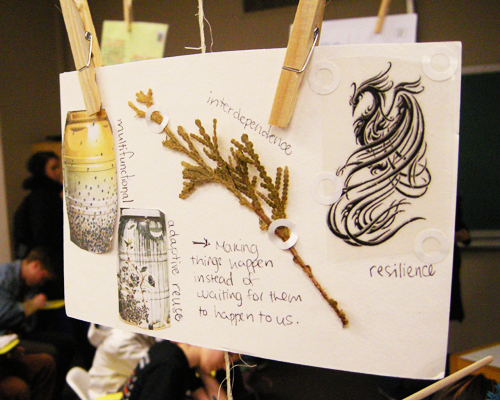
Final projects for university classes typically take the form of lengthy essays or poster presentations, but the 132 students in Introduction to International Development Studies (IDEV 2500) had a chance to show off a little with multi-media projects that included T-shirts, postcards hung in a mobile that dangled down from the ceiling, and a video featuring students reciting poetry they’d written.
This teaching strategy builds on the success of an idea course instructor Ashlee Cunsolo Willox used last year: the entire class creates a video, using photos of student messages about their hopes for the future. These projects, which are voluntary, have seen more than 90 per cent of the students participating.
“We’ve been talking about boundaries, permeability and how art, music and media affect development and growth,” says Cunsolo Willox. “We thought that one of the projects of the year should reflect that.”
She adds that international development courses are inevitably difficult on an emotional level. “You’re hearing every day about atrocities, poverty and suffering, and it’s a tough thing to take on at this stage of life. But art moves us. It creates community. It transcends boundaries of language, culture and nationalities. It brings beauty into the equation and reminds us what can be done.”
Her winter-semester class was divided into six seminar groups advised by teaching assistants Lauren Scannell, a PhD student in geography and international development, and Émanuèle Lapierre-Fortin, a master’s student in rural planning and development. Each group designed and created a unique project that they presented to the rest of the class at the end of the term.
One seminar group designed and ordered black T-shirts with the words “Where does your (insert commodity here) come from?” printed on the front. On the back were the words “Where does your stuff really come from? Grown in Africa, Processed in Asia, Assembled in South America, Sold in North America, Made in?” Cunsolo Willox says this group recognized that commodities are all global, and we should question where everything comes from.
Another group made individually designed postcards with images and words to express concepts of international development on one side, and a message on the other. These were hung on a mobile that swayed as students came up to read the cards and take in the images.
A third seminar group opted to paint the cannon with the slogan “our world, our change” and to take photos of themselves as they worked. “The slogan represents what international development students do; we come together to make change,” said one member of the group.
The video of one seminar group reciting poems they had written about their experience in the course also featured music composed by a group member and photos showing the students involved in volunteer work around the world, helping with projects such as Habitat for Humanity. “The idea was that we all do our part, and this is what we can accomplish as a group,” the presenter explained.
The other two seminars also produced videos. One group started with a large hand-drawn map of the globe that was cut into puzzle pieces; the students in the seminar each took a piece, wrote a word or two related to international development on the puzzle piece, and put the map back together on the floor in the middle of the University Centre. The other group used large squares of cardboard with illustrations and the Margaret Mead quote, “A small group of committed people can change the world; indeed, it is the only thing that ever has.” Put together, the squares create a larger image of a globe.
“This was a way for the students to reflect on what they’d learned and share that with the rest of the class,” says Cunsolo Willox. “Development is not just about pain and strife, it’s also about beauty and art and creativity. I think they did an amazing job of coming together as a community and creating meaningful messages to share amongst themselves and with others.”
Click here to visit Cunsolo Willcox’s class website and view the videos produced by her students.